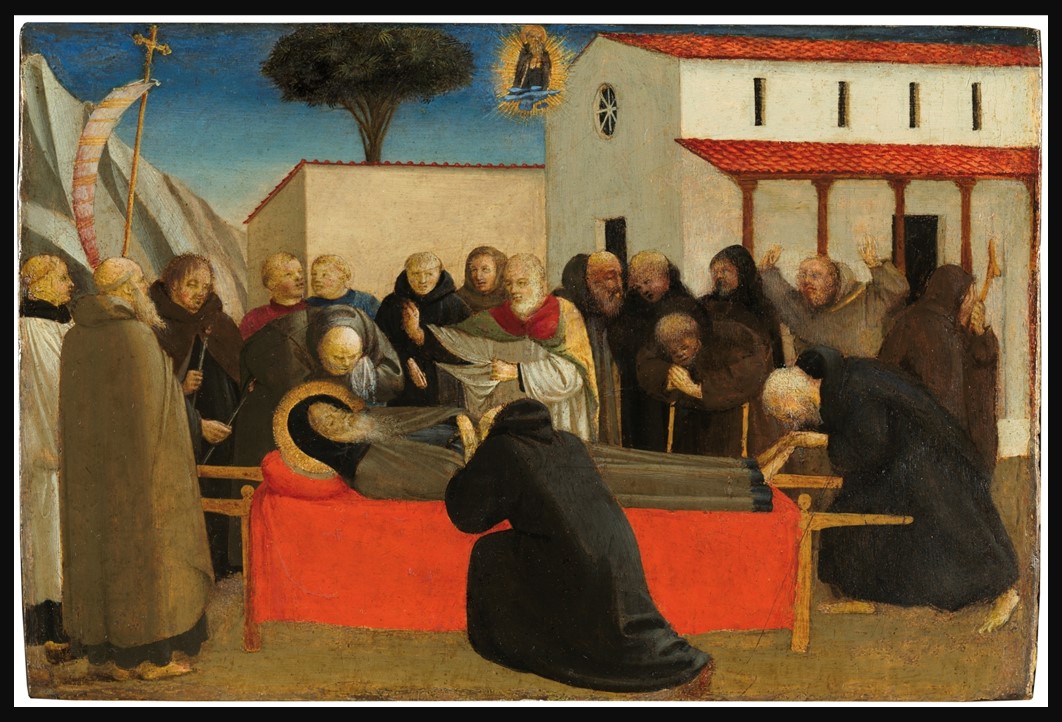
The Virgin with the Pomegranate, ca. 1426, Tempera on Panel, 87×59 cm, Prado Museum, Madrid, Spain https://www.museodelprado.es/en/the-collection/art-work/the-virgin-with-the-pomegranate/61b654df-1de2-483f-88bb-404f37747d4a?searchid=55f3ec41-7c92-bebf-e83c-b0e5c7f74a9f
Fra Giovanni Angelico of Fiesole, known in the world as Guido, was no less excellent as a painter and illuminator than as a monk of the highest character, and in both capacities, he deserves to be most honourably remembered. Although he might easily have led a secular life and gained what he liked at art beyond what he possessed, for he showed great skill while still quite young, yet being naturally quiet and modest, he entered the order of Friars Preachers 1 chiefly for the sake of his soul and for his peace of mind… As I ponder Giorgio Vasari’s words about this serene soul, my mind drifts to his masterpiece, The Virgin with the Pomegranate, housed in the Prado Museum. The painting radiates the same tranquility and depth of faith that guided Fra Angelico’s life, its vibrant yet tender hues evoking a sacred moment of grace. https://www.artist-biography.info/artist/fra_giovanni_angelico/ Giorgio Vasari, Lives of the Most Excellent Painters, Sculptors, and Architects, first published in 1550 and dedicated to Grand Duke Cosimo I de’ Medici
Fra Angelico, born Guido di Pietro around 1395 near Fiesole in Tuscany, was a prominent early Renaissance painter known for his deep spirituality and serene artistic vision. He initially trained as a manuscript illuminator before entering the Dominican Order of Friars Preachers in Fiesole, taking the name Fra Giovanni. His religious commitment deeply influenced his work, and he spent much of his career painting frescoes for monasteries and churches, including the renowned frescoes at the Convent of San Marco in Florence. Fra Angelico’s reputation as both a devout monk and a master painter earned him admiration across Italy, and in 1982, he was beatified by Pope John Paul II for the holiness reflected in his art. His works, characterized by their radiant colour and graceful compositions, brought the spiritual themes of the Christian faith to life with a profound sense of reverence.
Aesthetic values were central to Fra Angelico’s approach, reflecting his deep religious conviction and his desire to evoke the divine. He believed that art was a form of prayer and aimed to create works that inspired contemplation and devotion. His use of light and colour was symbolic, often representing the heavenly and the sacred, with soft, luminous tones that infused his figures with an ethereal quality. Fra Angelico’s compositions, whether in fresco or panel painting, emphasized harmony, balance, and simplicity, reflecting the spiritual ideals of humility and grace. His figures, especially his depictions of the Virgin Mary and angels, are known for their gentle, serene expressions, which convey a sense of inner peace. Through his artistic choices, Fra Angelico sought not only to beautify religious spaces but also to uplift the soul, making the divine more accessible to the viewer.

The Virgin with the Pomegranate (detail), ca. 1426, Tempera on Panel, 87×59 cm, Prado Museum, Madrid, Spain
https://arthive.com/artists/2681~Fra_Beato_Angelico/works/566563~Madonna_with_pomegranate_Fragment_Mary_and_the_Angels
The Virgin of the Pomegranate is a masterpiece painted by Fra Angelico during a pivotal moment in the early 15th-century Florentine Renaissance. This work is a stunning example of the spiritual and artistic transformation taking place during the Quattrocento period. The painting stands out not only for its delicate beauty and religious significance but also for its rarity—being one of the few masterpieces of its era that was up until 2016, still in private hands. As Italian Renaissance art began to capture the attention of collectors and critics in the 19th century, most works by figures like Fra Angelico, Masaccio, and Masolino became housed in major European and American museums, making The Virgin of the Pomegranate even more exceptional. The Prado Museum acquired the painting in 2016 for 18 million Euros. The purchase was made possible through contributions from the Spanish state, the Fundación Amigos del Museo del Prado, and from the museum’s own funds.
Alongside this purchase, the Duke of Alba donated another Fra Angelico work, The Funeral of Saint Anthony Abbot, further enriching the museum’s collection of early Florentine art so that… all Spaniards and art lovers from every part of the world who visit the Prado and admire this most important Museum will have a better understanding of the master’s artistic achievements. http://www.alaintruong.com/archives/2016/01/26/33272102.html

The Funeral of Saint Anthony Abbot, 1426 – 1430, Tempera on Poplar panel, 19.7×29.3cm, Prado Museum, Madrid, Spain https://www.museodelprado.es/en/the-collection/art-work/the-funeral-of-saint-anthony-abbot/1af1dc35-845c-43d3-b701-f5f9747e3113
Both paintings showcase Angelico’s mastery of delicate lines, soft color palettes, and ethereal figures. The Virgin’s serene expression, in particular, and the tender interaction with the child reflect a deep sense of spiritual devotion. The gold background creates a divine atmosphere, evoking the sacredness of the scene. Fra Angelico’s balanced composition and attention to detail enhance both paintings’ meditative and contemplative quality.
For a PowerPoint Presentation titled 10 Masterpieces by Fra Angelico, please… Check HERE!
For an interesting Video on Fra Angelico’s painting The Virgin with the Pomegranate, please Check…https://www.museodelprado.es/en/whats-on/multimedia/the-virgin-of-the-pomegranate-and-the-funeral-of/60b91c7a-86e2-47c7-8323-3341d196d7d6